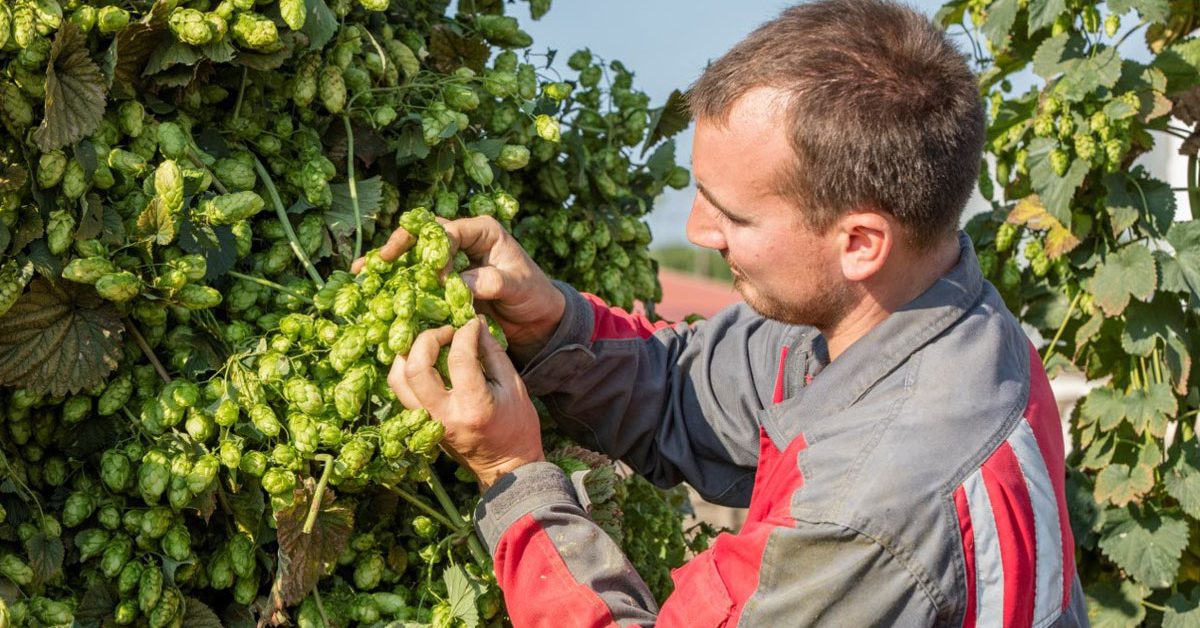French hop growers are small fish in a big pond. With 2.2 million pounds produced in 2023, France is the 10th-largest hop-producing country in the world, representing less than 1 percent of global growing areas. In comparison, 15.4 million pounds were produced in Czechia that same year, 90.9 in Germany, and 104.9 in the U.S.
The oldest documented evidence linking hops with brewing comes from northern France in 822, where hop culture became a flourishing trade eight centuries later, before Alsace, in eastern France, entered the game in the 19th century. Growing hops in France is not a new enterprise, but it has always been a tricky one.
In 1929, while the production volume was reportedly enough to cover the country’s needs, hop growers were struggling to sell their crop and brewers were mainly buying from Czechia, Poland, or Yugoslavia.
A newspaper from the time stated that customs fees should be increased to compete with the lower prices and cheaper workforce of those countries (those same taxes were lowered in the 1880s, taking a toll on sales for French producers).
Increasing taxes didn’t help much and, in 1937, an Alsatian senator even suggested limiting the use of foreign hops for the benefit of French hops, asking that two-thirds of the hops used by French breweries come from France and the remaining third from abroad.
The reality is that, despite good soil quality, an adequate climate, and abundant agricultural skills, French hop growers have been competing with much more established countries when it comes to beer, and taxes or regulations were never really able to change that.
Philippe Martin, in charge of microbreweries at Hop France, France’s biggest producer and supplier, believes that French hops are still waiting to be put on the map. “Our noble varieties like Strisselspalt are not really featured in traditional beer recipes along with Saaz or German hops,” he says.
Now the competition also comes from across the Atlantic. The craze for American beer styles in the French beer scene heavily influences raw materials, especially hops. (A study from 2018 shows that 35 percent of French breweries use American hops and 20 percent use French hops.)
Historic French producers are putting forth their best efforts to convince brewers to give their hops a try by creating varieties designed to fit the latest trends, while new producers have emerged from around the country with a range of American hops to meet demand.
Not on the IPA Bingo Card
It’s in Alsace that 80 percent of French hops are produced, with Strisselspalt the bestseller. Grown since at least 1885, this traditional variety is often used in bottom-fermented beers such as Kronenbourg 1664.
But being associated with macro lager brands hasn’t helped Strisselspalt thrive in a craft beer scene thirsty for hoppy recipes. While Hop France sells 60 percent of its production in France, microbreweries represent only 15 percent of their French clients.
Martin thinks this has to do with French hops’ overall profile. “French hops are here to smooth things out and improve drinkability. It’s harder to sell because we’re not selling an aroma,” he says. “The craft segment wants hops for IPAs—aromatic bombs.”
Since 2009, Hop France’s research program has developed new varieties to meet this demand. Elixir, launched in 2016, has specifically been designed to fill the IPA bingo card, with a citrusy flavor profile. Francis Heitz, Hop France’s export manager, calls it the most American of European hops.
Still, as French beer lovers tend to attach significance to the hops used in NEIPAs, hazy IPAs, and other hop-focused recipes, a blend of French hops can appear less appealing and marketable than using well-known combos such as Citra, Mosaic, and Simcoe.
On the other hand, some renowned American breweries have found an interest in French hops’ distinctive profiles (the U.S. represents 3.8 percent of Hop France’s sales). Oskar BluesOpens in new window’ Mama’s Little Yella Pils and Russian RiverOpens in new window’s STS Pils both contain Aramis, a variety more bitter than Strisselspalt, launched in 2010. Created in 2018, Barbe Rouge and its ripe red fruit aromas have made their way into New BelgiumOpens in new window’s Fat Tire Ale recipe.
At Urban Chestnut Brewing CompanyOpens in new window in St. Louis, Missouri, founder Florian Kuplent says he fell in love with French hops a long time ago.
“Strisselspalt is one of those classic hop varieties that has a very nice herbal, mild, but very distinct character that really works well in our Pilsner,” he says, as the hop features in Stammtisch, a German Pilsner. “It’s very low in alpha, so the bitterness level is relatively low, but the aroma and flavor impact are quite high.”
Kuplent uses Aramis in several recipes as well, such as Zwickel Light, a light lager, but also Fantasyland, an IPA. “We don’t use it so much for specific IPA flavor or aroma, but that hop provides a nice, clean, very smooth bitterness,” he says, echoing Martin.
An Act of Support
In France, some breweries are determined to prove that French hops can find their place in IPAs. At La Dilettante in Brittany, head brewer and associate Frédéric Favennec says his one condition when working on a double IPA recipe was using French hops exclusively.
“It was a challenge because people now expect certain things from this style, something really juicy and aromatic,” he says. “We used Elixir and Mistral from Alsace and Chinook grown in Brittany. Since the beer was launched in March, the response from our clients has been huge.”
Through the years, the brewery has been replacing U.S. hops with French ones. Favennec says he doesn’t want to stop using American hops entirely, but desires to be less reliant on them. “We’re an organic and local brewery, so buying raw materials that haven’t arrived here by plane makes more sense.”
But the substitution isn’t always successful and Favennec is still trying to find a suitable hop for the brewery’s bestseller, a single-hop Session White IPA. The hop in question, Citra, is not the kind that can be replaced easily.
“We tried to change the recipe, using less Citra and adding some Elixir,” Favennec recalls. “But every time we tried something, people complained. They know the beer too well and like it that way. I may be stuck with using Citra on this one.”
It would be a mistake to assume that the American influence has only been negative for hop production in France. The rise of microbreweries in the country (from 500 in 2013 to more than 2,500 in 2023) echoing the U.S. beer market produced a new customer base for French hop growers like Hop France, who used to export more than it sold in France.
Other producers started emerging across the country, even in regions not historically linked to hop culture. In Brittany, Erwan Jouan started producing organic American and British varieties four years ago at his hop farm, Le Hangar à Houblon.
While he struggles to sell British varieties such as Fuggles (he says he’s currently tearing them out to be replaced with Triumph), Jouan has good feedback on his American ones. “Cascade and Chinook are definitely the hops I’m selling the most, which is great because they really like Brittany’s climate. They’re robust with nice alpha acids.”
A few years ago, Favennec replaced U.S. Cascade with those grown on Jouan’s hop farm and says he hasn’t noticed any difference between the two recipes, and neither have his clients.
Hop France also grows American varieties, but doesn’t want to depend on them. “When there’s too many Cascade produced in the U.S., prices are low and people won’t buy ours,” Martin says. “And we’re not pretending that our Cascade is better than the one grown in the U.S. anyway. It’s with our own varieties that we’ve been able to differentiate ourselves and be less dependent. Research saved us.”
Though they believe in the quality of their product, Jouan and Martin both think that for small breweries, buying French hops is first and foremost an act of support.
“Some breweries aren’t organic but buy our hops because we’re local hop growers. They accept to pay a little bit more than with conventional hops to support us,” Jouan says. “In terms of aromas and price, we can be competitive, if breweries are curious enough to give our hops a chance.”
CraftBeer.com is fully dedicated to small and independent U.S. breweries. We are published by the Brewers Association, the not-for-profit trade group dedicated to promoting and protecting America’s small and independent craft brewers. Stories and opinions shared on CraftBeer.com do not imply endorsement by or positions taken by the Brewers Association or its members.


Share Post